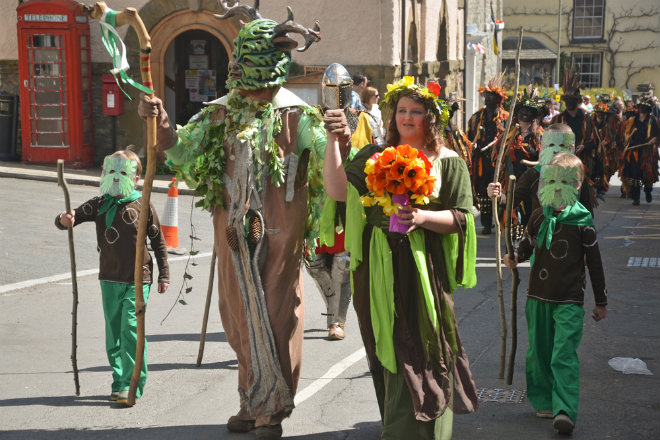Crisp leaves, beer, and a spirit of school pride all mark homecoming weekends at colleges and high schools across the country—and, of course, the crowning of a queen with a requisite sash and tiara.
Royalty, though, did not always grace homecoming celebrations. The University of Missouri, which held one of the first homecomings in 1911, didn’t crown homecoming queens until the 1930s. Kings didn’t come until the 1970s.
Young women were the primary recipients of fake royalty titles because they’re the most disempowered people in many social hierarchies.
But the university did crown queens for other events before that, like for a farmers fair for the agriculture school and a carnival for the journalism school, according to school archivist Gary Cox. It’s not just a collegiate activity, either: We crown young women for all sorts of events, from the Rattlesnake Roundup in Sweetwater, Texas, to the Sweet Corn Festival in Mendota, Illinois.
So why must there be homecoming royalty? The answer requires looking at why we crown royalty for plebeian events at all.
Perhaps unsurprisingly, the tradition has origins in the May Day celebration in medieval Europe, when a girl would be selected and crowned Queen of May, a symbol of purity and fertility. Judging women, it turns out, is an easy way for cultures across the globe to project their cultural values and identities in a public setting, under the guise of entertainment or building loyalty and pride for groups. Anthropologists consider carnivals and festivals like May Day to be a time when social order is inverted—meaning the least powerful get “exalted status,” says Susan Dewey, an anthropologist at the University of Wyoming who has studied pageants in India. In that case, young women were the primary recipients of fake royalty titles because they’re the most disempowered people in many social hierarchies.

The Green Man and May Queen in the 2013 May Day Procession in Clun, Shropshire, U.K. (Photo: Maisna/Shutterstock)
But the power of the crown beyond coronation is questionable. In modern beauty pageants where the queen receives prestige, scholarship money, or a degree of influence in her community, getting to the top often requires diligent and expensive grooming to adhere to the stereotypical standards of beauty and poise. (Not to mention, most of the women end up losers.)
The power of the pageant is that it’s an easily reproducible format for a culture to project its own ideals, explains Karen Tice, author of Queens of Academe: Campus Pageantry and Student Life, a book on beauty pageants at universities. Despite masquerading as a form of empowerment, pageants are used as tools to police how women should look and act. Even as those cultural ideals have changed, “The pageant format has been tenacious,” Tice says. “People have stretched it to fit all kinds of agendas.”
In research for her book, Tice interviews scholarship pageant contestants and some self-described feminists who say it’s all about money and empowerment, rationalizing swimsuit portions as demonstrations of “discipline.” Born-again Christian contestants sometimes say they want to win to “extend the work of Jesus.” And Dewey, who studied Indian beauty pageants, says many contestants saw their participation as another step in their country’s path toward economic modernity.
DESPITE THEIR REPUTATION OF prizing intellect above all else, Tice’s book explains, pageants became popular at colleges in the 1920s, representing a microcosm of societal ideas at the time. Homecoming was just another event that included a pageant as part of the festivities. Back then, beauty contests at both white and historically black colleges were some of the few extracurricular activities in which women could participate to gain prestige.
For white women, the pageants helped reaffirm the status quo of gender relations in a time when the existence of college students drove fears that the traditional family unit would implode. Vying for “campus cutie” was a way for the women to show that their studies wouldn’t stop them from all-important female matters of getting married and having babies.
Pageants at black colleges, meanwhile, focused on challenging the idea that black women weren’t as beautiful or moral as white women. Yet, mostly light-skinned black women wearing white gloves and pearl necklaces won the pageants in the early years.
By the 1960s, those ideals were changing, and pageants had to adapt. Students argued that the contests were shallow and sexist, so talent and interview portions were added. Some dropped swimsuit portions. Darker-skinned women and women with Afros started participating in black pageants, and short “African culture” segments were often added.
Male pageants also became more popular, though never as serious as their female counterparts.
TICE CREDITS THE CONTINUED popularity of pageants to reality-television culture and people’s desire for celebrity in modern life. At this point, the tradition’s so embedded that it’s unlikely to ever go away. “It’s just deeply rooted in university culture in all the different ways we showcase fit and attractive bodies,” she says.
Whether they’re being judged on looks, popularity, or the ability to respond to basic questions, women ultimately are still willing to compete. Young women across the world will still take months to choose dresses, try on shoes, and plan make-up for events like prom, pageants, and homecoming. While it might seem easy to dismiss as a farce, “it’s also the human power of hope,” Dewey says. “Like, ‘I’m putting on this display, this thing I aspire to be. I aspire to be beautiful and sparkly and well-spoken and smart.’ There’s great power in that.”




